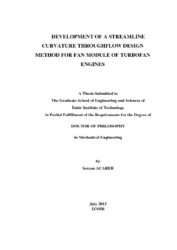Please use this identifier to cite or link to this item:
https://hdl.handle.net/11147/4452| Title: | Development of a Streamline Curvature Throughflow Design Method for Fan Module of Turbofan Engines | Other Titles: | Turbofan Motorların Fan Modülü için Akım Çizgisi Eğriliği Metodu ile Eksenel-simetrik Tasarım Metodu Geliştirilmesi | Authors: | Acarer, Sercan | Advisors: | Özkol, Ünver | Keywords: | Turbo compressor system Gas jet Axial flow fan Axial flow compressor Turbojet engine Turbomachinery Two dimensional modelling Computational fluids dynamic |
Publisher: | Izmir Institute of Technology | Source: | Acarer, S. (2015). Development of a streamline curvature throughflow design method for fan module of turbofan engines. Unpublished doctoral dissertation, İzmir Institute of Technology, İzmir, Turkey | Abstract: | Through-flow modeling of turbomachinery flows is the principle tool for inverse design, off-design analysis and post-processing of test data, due to its capability to simulate the principal aspects of turbomachinery flows, swirling flow with rotors and stators, in the axisymmetric meridian plane with minimum two orders of magnitude smaller computational time compared to three-dimensional analysis methods. Turbomachine energy equation and empirical models for incidence, deviation, pressure loss and blockage are used to define source terms for an axisymmetric compressible flow solution. Even though the subject has been studied in numerous aspects for compressors and turbines, open literature on fully coupled fan and splitter design of turbofan engines is still limited.
The present study addresses this void by developing a new split-flow method for inverse streamline curvature flow solution methodology in the course of this thesis. Hybridized empirical models that are compiled from the literature are implemented as a baseline to be calibrated.
The method is validated both experimentally and numerically on a total of six different test cases within a three-step validation strategy. Firstly, split-flow solutions of the developed method for three representative duct geometries, but without a turbomachinery, are validated. Secondly, two different single-stream transonic fans, NASA 2-stage fan and a custom-designed fan stage are used to experimentally and numerically validate the empirical models, respectively. Thirdly, experimental data of GE-NASA by-pass fan is used to validate the complete models.
It is shown that the accuracy of solutions in the tested cases are within less than 1.6% in pressure ratio, 2.3% in efficiency, 8% in velocity and 1.8 degree in flow angle. With this accuracy level, the proposed method is shown to be valid and can be implemented into existing compressor streamline curvature methodologies with minimal numerical effort. Turbo makine akışlarının eksenel-simetrik modelleri, tersine tasarım, analiz ve test verisinin işlenmesinde ana araçlardır. Bu metodların gücü, bu akışların esasen çevreselde ortalanmış akışta rotor ve stator kaynaklı akış döngüleri ile temsil edilebilmesinden kaynaklanmaktadır. Bu sayede hesaplama süresi üç boyutlu analiz metodlarının en az yüzde biri mertebesindedir. Bunu gerçekleştirmenin yolu ise turbo makine enerji denklemleri ile birlikte görgül kanatçık basınç kaybı, isabet açısı, sapma açısı ve tıkama modellerinin her kanadın kökünden ucuna kadar akış çözümüne tanımlanmasıdır. Konu kompresör ve türbinler için açık literatürde birçok açıdan çalışılmasına rağmen turbofan motorların fan ve ayırıcı sistemlerinin tersine tasarımı için yapılan çalışmalar çok kısıtlıdır. Bu çalışmanın amacı, bu eksikliği gidermek için yeni bir ayrık akış metodunun akım çizgisi eğriliği tersten akış çözüm metodu için geliştirilmesidir. Çözücüye eklenecek görgül modeller ise literatürden kalibre edilmek üzere derlenmiştir. Metod hem deneysel hem de sayısal veri ile toplam altı değişik model üzerinde üç aşamada doğrulanmıştır. İlk olarak, kanatçık içermeyen ve sadece eksenel-simetrik ayrık akışlı kanal çözümünü doğrulamak için tasarlanan üç farklı model kullanılmıştır. Sonraki aşamada bahsi geçen görgül modeller transonik ve ayrık akış içermeyen NASA 2-kademe fanı ve tezin kapsamında tasarlanmış fan kademesi üzerinde sırasıyla deneysel ve sayısal verilerle doğrulanmıştır. Son aşamada ise GE-NASA ayrık akışlı fan sistemi kullanılarak tüm modellerin deneysel doğrulaması yapılmıştır. İncelenen geometriler için hesaplamalarda gözlemlenen en büyük hatalar basınç oranı için 1.6%, verim için 2.3%, hız için 8% ve akış açısı için 1.8 derecedir. Tüm bu çalışmalar sonucunda geliştirilen metodun doğruluğu gösterilmiştir ve mevcutta bulunan ayrık akış içermeyen kompresör eksenel-simetrik metodlarına asgari çaba ile uygulanabilirdir. |
Description: | Thesis (Doctoral)--Izmir Institute of Technology, Mechanical Engineering, Izmir, 2015 Full text release delayed at author's request until 2018.07.29 Includes bibliographical references (leaves: 133-141) Text in English; Abstract: Turkish and English xvii, 163 leaves |
URI: | http://hdl.handle.net/11147/4452 |
| Appears in Collections: | Phd Degree / Doktora |
Files in This Item:
| File | Description | Size | Format | |
|---|---|---|---|---|
| T001383.pdf | DoctoralThesis | 3.39 MB | Adobe PDF |  View/Open |
CORE Recommender
Page view(s)
1,006
checked on May 26, 2025
Download(s)
1,518
checked on May 26, 2025
Google ScholarTM
Check
Items in GCRIS Repository are protected by copyright, with all rights reserved, unless otherwise indicated.